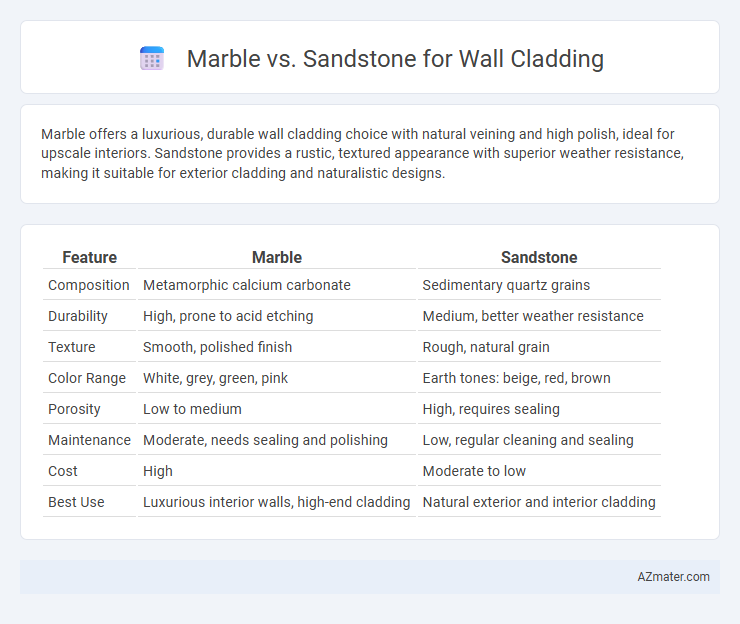Marble offers a luxurious, durable wall cladding choice with natural veining and high polish, ideal for upscale interiors. Sandstone provides a rustic, textured appearance with superior weather resistance, making it suitable for exterior cladding and naturalistic designs.
Table of Comparison
| Feature | Marble | Sandstone |
|---|---|---|
| Composition | Metamorphic calcium carbonate | Sedimentary quartz grains |
| Durability | High, prone to acid etching | Medium, better weather resistance |
| Texture | Smooth, polished finish | Rough, natural grain |
| Color Range | White, grey, green, pink | Earth tones: beige, red, brown |
| Porosity | Low to medium | High, requires sealing |
| Maintenance | Moderate, needs sealing and polishing | Low, regular cleaning and sealing |
| Cost | High | Moderate to low |
| Best Use | Luxurious interior walls, high-end cladding | Natural exterior and interior cladding |
Introduction to Marble and Sandstone Wall Cladding
Marble wall cladding features a natural crystalline structure that offers a polished, elegant finish with superior durability and resistance to scratches, making it ideal for high-end interior and exterior surfaces. Sandstone wall cladding provides a textured, earthy aesthetic with excellent weather resistance and thermal insulation properties, favored in rustic and traditional architectural designs. Both materials offer unique visual appeal and functional benefits, but marble typically demands more maintenance due to its susceptibility to staining compared to the porous yet hardy nature of sandstone.
Aesthetic Appeal: Marble vs Sandstone
Marble offers a luxurious, polished aesthetic with its smooth surface and natural veining patterns, providing a timeless elegance ideal for high-end wall cladding. Sandstone features a more rustic, textured appearance with earthy tones that create a warm and natural ambiance suited for both traditional and contemporary designs. The choice between marble and sandstone ultimately depends on the desired visual impact and architectural style, with marble emphasizing sophistication and sandstone enhancing organic charm.
Durability and Longevity Comparison
Marble offers superior durability and longevity for wall cladding due to its dense crystalline structure, making it highly resistant to weathering and surface wear. Sandstone, while aesthetically versatile, is more porous and prone to erosion and staining over time, requiring regular maintenance to preserve its appearance. Choosing marble ensures a longer-lasting, low-maintenance wall cladding solution ideal for both interior and exterior applications.
Maintenance and Cleaning Requirements
Marble wall cladding demands regular sealing and gentle cleaning with pH-neutral solutions to prevent etching and staining, making it higher maintenance compared to sandstone. Sandstone is more porous and prone to dirt accumulation but requires less frequent sealing and can be cleaned with mild detergents without damaging the surface. Choosing between marble and sandstone for wall cladding depends on the desired aesthetic and willingness to commit to their specific maintenance routines.
Installation Process: Marble vs Sandstone
Marble wall cladding requires precise cutting and polishing due to its dense structure, necessitating skilled labor and specialized equipment for a smooth finish. Sandstone, being softer and more porous, is easier to cut and install, allowing for quicker and more cost-effective application with standard tools. Both materials demand proper anchoring systems to prevent detachment, but sandstone's lighter weight generally simplifies the installation process compared to marble.
Cost Analysis: Which is More Budget-Friendly?
Marble wall cladding typically costs between $50 to $150 per square foot, making it a premium choice due to its durability and aesthetic appeal. Sandstone is generally more budget-friendly, with prices ranging from $20 to $60 per square foot, offering a natural look at a lower initial investment. For projects with tight budgets, sandstone provides a cost-effective solution, while marble presents higher upfront costs but may offer long-term value through enhanced property aesthetics.
Weather Resistance and Performance Outdoors
Marble offers superior weather resistance due to its dense, non-porous surface that withstands rain, wind, and temperature fluctuations without significant erosion or discoloration. Sandstone, being more porous and softer, tends to absorb moisture, leading to potential frost damage and surface wear in harsh outdoor conditions. For long-term outdoor wall cladding, marble provides enhanced durability and maintains aesthetic integrity better than sandstone.
Environmental Impact and Sustainability
Marble and sandstone differ significantly in environmental impact and sustainability for wall cladding. Marble extraction involves energy-intensive quarrying processes with high carbon footprints and generates substantial waste, whereas sandstone is generally sourced with lower environmental disruption and requires less energy to process. Sandstone offers better sustainability due to its abundance, durability, and lower embodied energy, making it a more eco-friendly choice for wall cladding applications.
Best Applications for Marble and Sandstone
Marble is ideal for luxury interior wall cladding due to its elegant, smooth finish and durability in dry environments, making it perfect for living rooms, bathrooms, and commercial lobbies. Sandstone excels in exterior wall cladding because of its natural texture, weather resistance, and excellent insulation properties, suited for patios, garden walls, and building facades. Both materials offer distinct aesthetic and functional benefits tailored to specific climatic and architectural needs.
Conclusion: Choosing the Right Material for Your Wall Cladding
Marble offers a luxurious, polished finish with high durability and resistance to stains, making it ideal for elegant and long-lasting wall cladding. Sandstone provides a natural, textured appearance with excellent weather resistance, suitable for rustic or outdoor applications. Selecting between marble and sandstone depends on the desired aesthetic, maintenance requirements, and environmental exposure of the installation site.

Infographic: Marble vs Sandstone for Wall Cladding
 azmater.com
azmater.com